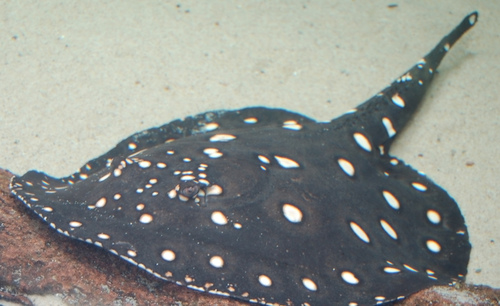
Leopold's Stingray
The Atlantic bluefin tuna (Thunnus thynnus) is a majestic and powerful fish, renowned for its size, speed, and commercial value. This highly migratory species plays a critical role in the marine ecosystem and is a prized catch in fisheries worldwide, particularly for sushi. However, its popularity has led to significant conservation concerns.
5 15 years
Lifespan
60 cm
Length
Near Threatened
Conservation Status
15 km/h
Swimming speed
Carnivorous
Diet
Local Migration
Migration
Appearance Overview
The Atlantic bluefin tuna is renowned for its large, streamlined body, built for speed and endurance in the open ocean.
Color
Dark metallic blue above, silvery white below
Body Shape
Torpedo-shaped, designed for efficient swimming
Fins
Two dorsal fins, the first depressible; small finlets run down the back and belly to the tail
Keel
Strong lateral keel on the caudal peduncle
Length
Up to 13 feet (4 meters), commonly around 6.5 feet (2 meters)
Weight
Up to 2,000 lbs (900 kg), commonly around 550 lbs (250 kg)
Diet
Carnivorous, feeding on a variety of fish (such as herring, mackerel, and hake), squid, and crustaceans.
Feeding Behavior
Highly active predator, using speed and agility to hunt. They often hunt cooperatively, herding prey fish into tighter formations.
Social Behavior
Forms large schools, especially during migration and spawning. Schools may be segregated by size.
Commercial Relevance
Extremely high value, particularly in sushi and sashimi markets, where its fatty flesh is considered a delicacy.
Conservation measures
Subject to international fishing quotas, stock management plans, and monitoring efforts by organizations like ICCAT. Some areas have implemented stricter regulations.
Status
Endangered (Varies by population segment; some stocks are more depleted than others)
Threats
Overfishing (historically and ongoing, though regulations are in place), bycatch in fishing gear, climate change affecting prey distribution and spawning habitats.
Habitat Distribution
Depth Range
0-1,000 meters (0-3,280 feet), though more commonly found in the upper few hundred meters.
Geographic Range
Western and Eastern Atlantic Ocean, Mediterranean Sea, and historically in the Black Sea.
Preferred Environment
Temperate and subtropical waters; pelagic, open ocean environment. They tolerate a wide range of temperatures.
Reproduction and Life Cycle
Breeding Habits
Spawns in warm waters, with major spawning grounds in the Mediterranean Sea and the Gulf of Mexico. Spawning typically occurs from spring to summer.
Development Stages
Eggs are pelagic (float in the open water). Larvae develop rapidly, feeding on plankton. Juveniles grow quickly, forming schools.
Fecundity
Highly fecund; a large female can release up to 30 million eggs per spawning season.
Maturity Age
Reaches sexual maturity at around 4-8 years in the Mediterranean and 8-12 years in the western Atlantic.
Faqs about Leopold's Stingray
Where can I find Atlantic bluefin tuna?
Atlantic bluefin tuna are found in the Atlantic Ocean, ranging from the Mediterranean Sea to the Gulf of Mexico and the coast of Norway.
What do Atlantic bluefin tuna eat?
They primarily eat a variety of fish, squid, and crustaceans, adapting their diet based on availability.
Are Atlantic bluefin tuna dangerous?
While generally safe, caution is advised due to their size and strength. They are not typically aggressive towards humans unless provoked.
How fast are Atlantic bluefin tuna?
Atlantic bluefin tuna are among the fastest fish in the ocean, capable of reaching speeds up to 43 mph (70 km/h) in short bursts.
Are Atlantic Bluefin Tuna warm blooded?
They are warm-blooded, which allows them to maintain a higher body temperature than the surrounding water, aiding in muscle efficiency.
How many eggs do female tuna lay at a time?
Females can release millions of eggs per spawning season, though survival rates to adulthood are relatively low.
Are Bluefin Tuna known to migrate?
They are known for their long migrations, traveling thousands of miles between feeding and spawning grounds.
Copyright @ Nature Style Limited. All Rights Reserved.
 English
English